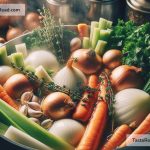Making Homemade Pet Food with Kitchen Scraps: A Guide for Pet Parents
As a pet parent, you understand the importance of keeping your furry friend healthy and happy. One of the ways to ensure your pet’s well-being is through its diet. While there are countless store-bought pet food options available, making homemade pet food from kitchen scraps can be a rewarding and nutritious alternative. Not only does it allow you to utilize leftovers that might otherwise go to waste, but it also gives you control over what your pet eats. Let’s explore how you can turn kitchen scraps into a culinary delight for your pet.
Why Consider Homemade Pet Food?
Before diving into the how-tos, it’s essential to understand why homemade pet food can be a great idea. Firstly, it’s eco-friendly. Using kitchen scraps reduces food waste, contributing to a healthier planet. Secondly, it can be cost-effective, saving you money on commercial pet food. Lastly, homemade meals can be tailored to your pet’s specific dietary needs, preferences, and allergies, ensuring they receive the right balance of nutrients.
Getting Started: What You Can and Can’t Use
Not all kitchen scraps are safe for pets. It’s crucial to know which foods are pet-friendly and which could be harmful. Safe options include cooked lean meats, rice, certain vegetables (like carrots and green beans), and fruits (such as apples without the seeds). Avoid onions, garlic, chocolate, caffeine, avocado, grapes, and raisins, as these can be toxic to pets.
A Simple Guide to Making Homemade Pet Food
1. Start with a Protein Base
Proteins are the building block of a healthy pet diet. Lean meats like chicken, turkey, and beef are excellent choices. You can use leftovers from your meals, ensuring they’re not seasoned with harmful ingredients like onion or garlic. Cook the meat thoroughly and chop it into small pieces appropriate for your pet’s size.
2. Add Vegetables for Vitamins
Vegetables are a great source of vitamins and minerals for pets. Carrots, peas, and green beans are pet favorites. Make sure they’re cooked and mashed or cut into small, digestible pieces. Avoid using vegetables that have been cooked with unsafe ingredients for pets.
3. Include a Carbohydrate Source
Carbohydrates provide essential energy. Cooked rice or pasta (without sauces or seasonings) can be a good source of carbs. Make sure these are cooled down and properly portioned before mixing them with the rest of the ingredients.
4. Balance with Fruits
Though not all fruits are safe for pets, many enjoy apples, bananas, and blueberries. These can be added in moderation for extra fiber and sweetness. Ensure all seeds and pits are removed to prevent any risks.
5. Add Supplements if Necessary
Sometimes, homemade meals might not provide all the necessary nutrients. Consulting with a veterinarian about adding specific supplements like omega-3 fatty acids or vitamins might be a good idea to ensure a balanced diet.
6. Mix and Serve
Once you have all your ingredients prepared, mix them to create a balanced meal. Start with a larger proportion of protein, adding vegetables and carbs accordingly. The final mixture should be easy for your pet to eat and digest.
Important Considerations
- Always consult with your veterinarian before changing your pet’s diet. They can provide guidance on nutritional needs based on your pet’s health, age, and breed.
- Gradually introduce homemade food to your pet’s diet. A sudden change can upset their stomach.
- Pay attention to your pet’s reaction to the new diet. If you notice any adverse effects, consult your veterinarian immediately.
Conclusion
Making homemade pet food from kitchen scraps is a fantastic way to utilize leftovers while ensuring your pet has a nutritious and balanced diet. Remember to use safe ingredients, introduce changes gradually, and consult with your veterinarian for a seamless transition. Not only will your pet enjoy delicious meals made with love, but you’ll also enjoy peace of mind knowing exactly what’s in their food. Start exploring the joy of cooking for your furry friend today!


